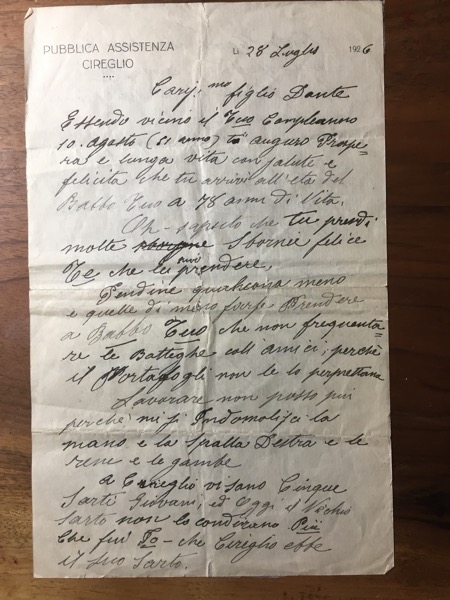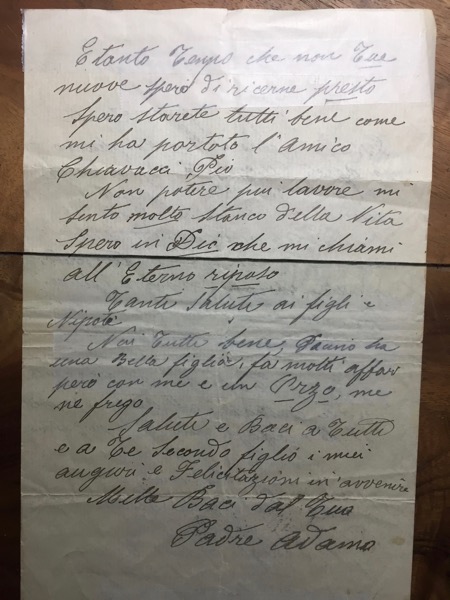« Argenta's third story | Main | "Your Cireglio" »
February 5, 2017
Happy birthday Dante Paci
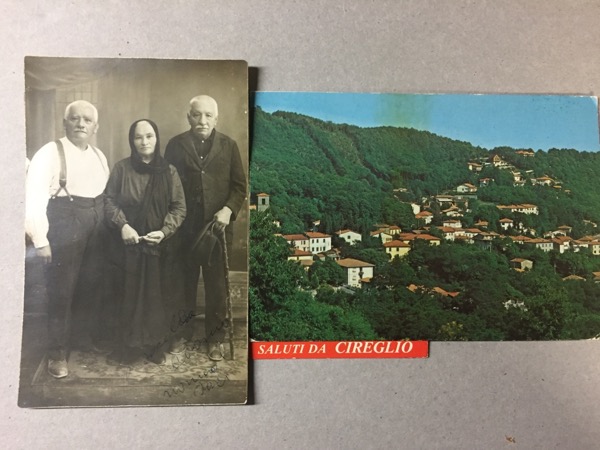
Adamo Paci on the right with his walking stick, with his brother and sister
Adamo’s birthday letter to his son Dante:
Cireglio, Italy - 28 Luglio 1926,
Carij (Caro), mio figlio Dante,
Essendo vicino il tuo compleanno 10 Agosto (51 anno) tuo auguro prospera e lunga vita con salute e felicita che tu arrivi all’ eta del babbo tuo a 78 anni di vita.
Adamo Paci, writes from his isolated Tuscan hill town near Pistoia to his second oldest son, now living at 146 Valley St. in Exeter, Pa.
My dear son Dante,
It is nearly your birthday on August 10, (51 years) I wish you a prosperous and long life, with health and happiness (and) that you (will) arrive at the age of your papa at 78 years of life.
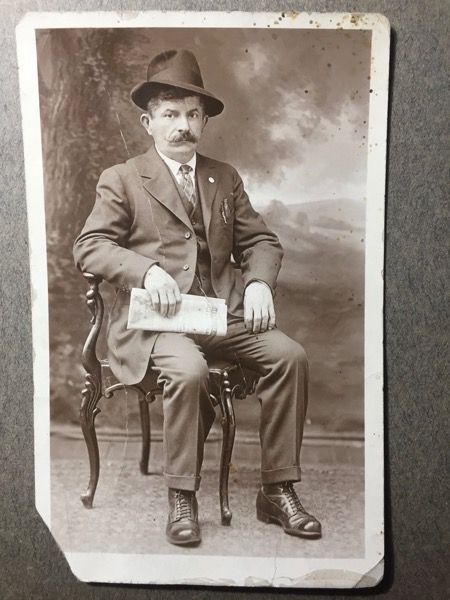
Dante Paci 1928
This letter may have been in response to the 500 lire Dante sent to Adamo that July. Dante was the second of two boys born to Adamo and his first wife Maria Leschi who died soon after Dante’s birth. Their first child, Ugo, was born in 1871.
In 1926, 500 lire was $26.32.
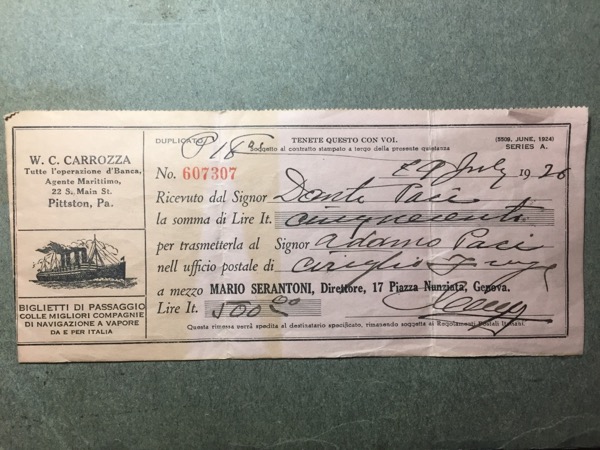
In Adamo’s Italy of July 1926, Vittorio Emanuel III is still king, but constitutional government is over and the country is now a dictatorship under Benito Mussolini.
Mussolini, prime minister of the constitutional government since 1922, has been dictator for a little over 7 months. But Italy has been seeing his squadristi - blackshirts - in action, and hearing Mussolini’s strident political voice for at least the last ten years declaring such things as Italy is in need of a strong man, ruthless, energetic, to make a clean sweep of the country and revive it. The state needs to be militarized, the education system needs to create a class of warriors, Italy needs to grow, colonize its inferior neighbors - the barbaric slavs and the inferior blacks of north Africa. We need more children and more space.
This may have been on people’s minds in urban Pistoia, nine miles down the hill from Adamo’s Cireglio, or in Florence, 30 miles to the southeast, but one has to wonder how much in the hill-town bar on Cireglio’s main street. In America, however, Mussolini is very much talked about, especially in Italian.
Around 1879 Adamo remarries to Argene Lippi and over the next 15 years they have 10 children. Of those, 3 come to America.
Dante Paci has been in America for about 12 years. Dante was 38 and his kid brother Cino was 22 when they arrived together in January 1914.
Big brother Giulio was 25 when he arrived 1908, and their sister Emma arrived in 1912 at the age of 30.
The men were miners, and by the time of this letter were well connected in the community, and surely grateful to have missed the developing disaster headed toward Italy and WW1 which claimed Lemmi Adriano Paci, Adamo’s ninth child with Argene Lippi who was close to his brother Cino and a year younger. At the time of WW1 one had to be a U.S. citizen to be eligible for the draft. Giulio may have been naturalized in 1912, but the rest were still Italian citizens.
Cino, Adamo and Argene's eighth child, paid a dollar in 1917 for a notorized Certificate of Examination declaring him to be a ‘Qualified Miner’ in the anthracite coal mines of Pennsylvania.
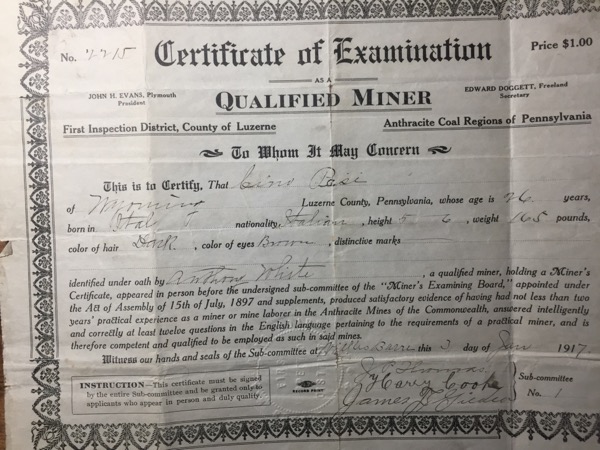
Giulio, Adamo’s third child with Argene, was the most well-traveled of the four now living in America. He was 43 at the time of this letter. By1926 he had, as a young man, worked on the Simplon railway tunnel through the Alps connecting Italy and Switzerland, sailed to America, traveled across the country, married, had a family, and traveled back to Pennsylvania.
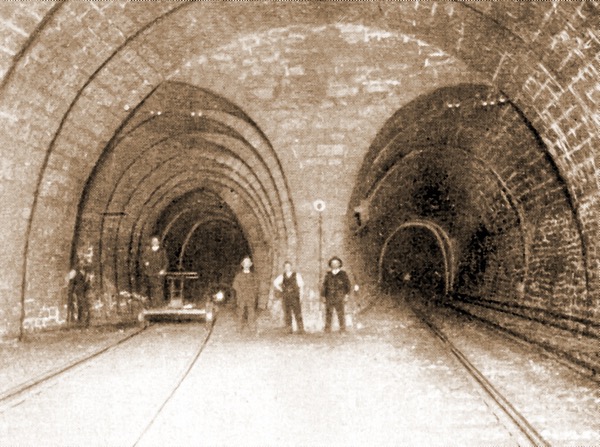
The tunnel opened in 1906, and Giulio arrived in America two years later to famously ‘pick the money off the trees.’ He went to Utah for mining work and in 1911 sent for the love of his life, Assunta Guazzeroni, to join him there. They moved from Utah to Wyoming, had two children and moved back to Pennsylvania around the time Dante and Cino arrived in 1914.
By July 1926 Guilio and Assunta, and their now five children lived at 122 Schooley St. in Exeter; and Cino and Fiorina lived in a house behind Giulio’s with the address of 122 R Schooley St.
Cino, now 35, and Fiorina, 32, had a 6 year old son Adriano at that time, and a 2 month old daughter Fedora.
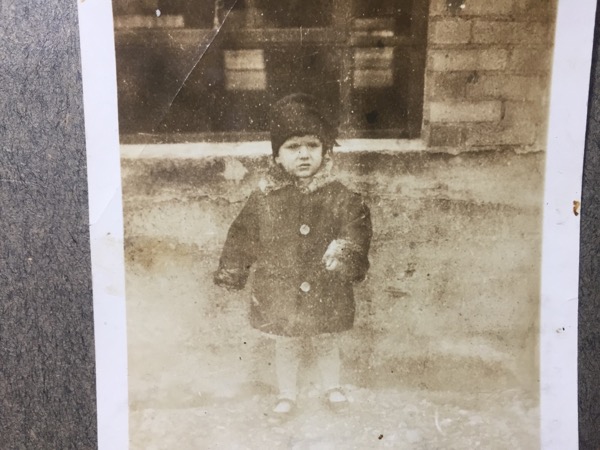
Fedora Paci
Giulio and Cino jointly bought the property at 122 Schooley in 1923 for $750. The property went from Schooley St. (‘street’ at the time, ‘avenue’ later) to the alley and presumably included two houses.
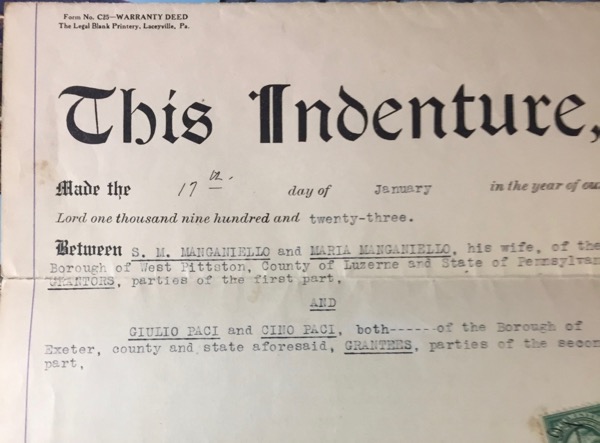
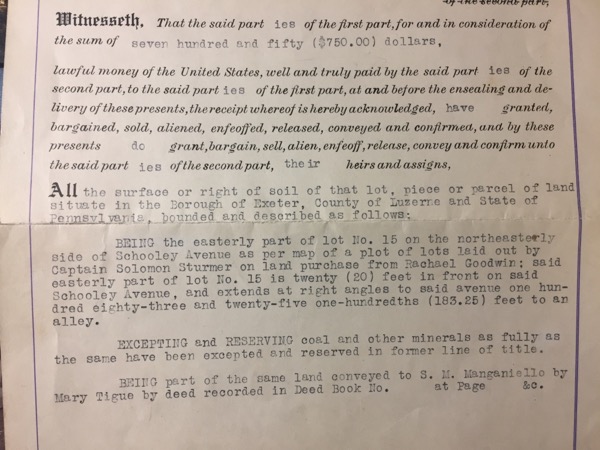
Dante, who remained a bachelor, lived a block away.
I’m not sure who started it, maybe all three of them, but a club called the North Italian Citizens Club was now three years old. By April 1931 the club listed about 66 members.
And the Wyoming Valley, as the area along the Susquehanna near Exeter, Pa. was called, was the go to place for people coming from the Pistoia area. The graveyards in Exeter and in Cireglio, Italy have matching names.
As Toscani Italians the Paci’s appeared to separate themselves from Capone’s crowd, as the name of the club is the ’North’ Italian Citizens Club.
Prohibition is in full swing. Al Capone is shooting up Chicago, and our Italians are making wine. It’s the roaring ’20s and the ‘north’ Italians are having the best years of their lives.
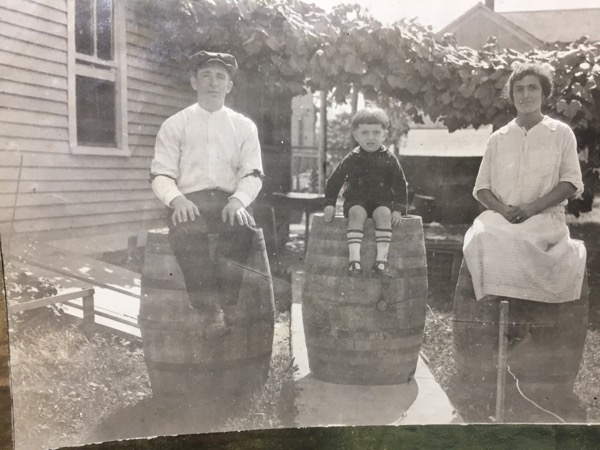
Cino Paci, Adriano and Fiorina 1924 (my grandparents and father - note the grape arbor)
The barrels are not lawn furniture. The Toscani were serious about making their wine, so serious that Cino spent $120 for grapes as seen in this 1928 check:
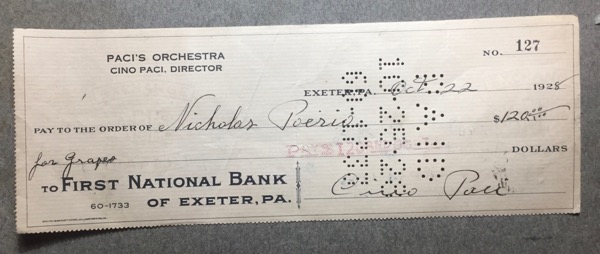
And Cino, a natural musician, started a band. In 1926 the band is three years old and going strong playing church and civic events and “marching" in parades. The band put Cino in touch with another 30 families. (Paci’s Band does not actually march, but rather ‘strolls’ in an orderly fashion while playing Cino’s original scores and other music of the day.)

Paci’s Band in 1927
Between the club, the band, and mining work the Paci’s were connected to a large community of people, probably greater than anything they could have imagined in the old country. And to top it off, a first cousin once removed from the Paci’s was a rising star in the United Mine Workers.
Here they all are:
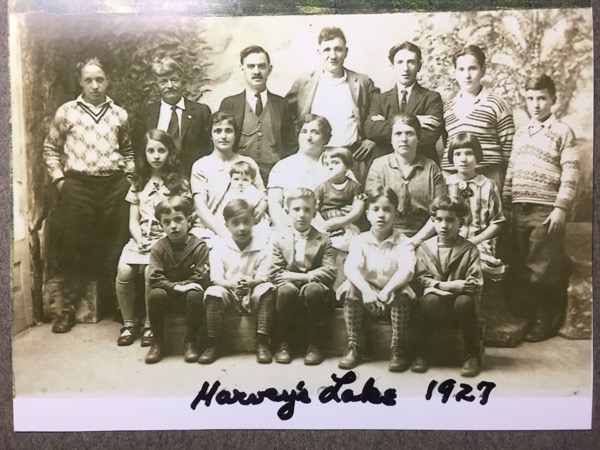
First row children left to right: Adriano (son of Cino and Fiorina), Spartaco Calvani (son of Emma and Arturo), Bino Paci (son of Giulio and Assunta), William Calvani (son of Emma and Arturo), Renzo Paci (son of Giulio and Assunta),
Middle row l-r: Wanda Calvani Toglia (daughter of Emma and Arturo), Fiorina Martini Paci with daughter Fedora, Emma Paci Calvani holding daughter Liberty Calvani (Prosperi), Assunta Guazzeroni Paci, Lydia Paci (Heffers) (daughter of Giulio and Assunta)
Back row l-r: Alfred Calvani, Dante Paci, Arturo Calvani, Giulio Paci, Cino Paci, George Fernando Paci (son of Giulio and Assunta), Lumberto Paci (son of Giulio and Assunta)
Emma and her husband Arturo Calvani are going to require a little excursion beyond the letter at hand.
From 1921 to sometime in ’23 or ’24 Arturo traveled with the circus of Italian radicals, anarchists, and civil rights leaders who were protesting the pending execution of Nicola Sacco and Bartolomeo Vanzetti, and were encouraging Italian American workers to resist the fascist government in Italy because of the concern of U.S. dollars getting into Mussolini’s hands.
The two causes went hand in hand in the speeches made at Italian clubs and labor halls, especially in the northeast U.S. Calvani gave his talks in Italian and in English.
Many in the group were labeled anarchists who, since the 1901 assassination of President McKinley by an anarchist, were now being closely watched by the Bureau of Investigation (named FBI in 1935) which at the time had as its deputy director J. Edgar Hoover. Anarchism had many faces, not all totally bad. A good one was Henry David Thoreau.
But the bomb throwers got the press and after 1901 immigrants had to sign a statement when they got off the boat that they were not anarchists.
Calvani’s name pops up several times online early in the Sacco/Vanzetti saga. The Oct. 21, 1921 issue of The Labor Journal, published by the American Federation of Labor, announced that Calvani and Elizabeth Gurley Flynn, organizer of the Workers Defense Union are starting a speaking tour through the New England states to speak against the execution of Sacco and Vanzetti who have just been sentenced. The alleged crime happened in Massachusetts.
His name pops up two years later on Oct. 23, 1923 in a report by Hoover’s boys who had, anticipating trouble, staked out a meeting in Providence, R.I. The meeting was part of the Flynn/Calvani New England Sacco/Vanzetti tour, but a visit two days later by the Italian ambassador of Mussolini’s Italy was also a hot topic. The activists expected him to appeal to Italian American workers for funds for Mussolini’s enterprises. Benito had a surprising amount of support here.
Flynn, one of the Founders of the American Civil Liberties Union, spoke first. The demands of labor, she said, are not complicated - better wages, working conditions, and more democracy. On fascism she said “International fascism is growing all around the world prompted by international capitalism.” And against Mussolini: “If Italy had one fair chance at a fair election, fascists would go to the political trash heap."
Arturo was up next and addressed the crowd in Italian. The report says he “criticized the hospitality shown to the Sons of Italy, and sarcastically joined in welcoming the police and the press.” He said that he hoped “the police and press would now be satisfied that they did not come to cause disorder….and he criticized some speakers who praised Italy for being under the rule of facism….fascism stands for oppression….Mussolini was crazy, but not as crazy as we thought; he is simply money mad. Italy is starving, the people must leave the country and come here."
The chairman of the meeting then told the people not to resort to violence when they hear delegates speak about fascism; and he referred to Sacco and Vanzetti as martyrs.
The next month, November 1923, Calvani was back on his home turf in the Pittsburgh area. He had five kids and a wife at his home there. A Pittsburgh newpaper reported that he addressed American and Italian citizens at a mass meeting at the Union Labor Temple. That’s the last reference to Arturo the agitator.
For more on Elizabeth Gurley Flynn: http://spartacus-educational.com/USAflynn.htm
By 1924, the exciting years are over, and Arturo is now a butcher in his own shop, Calvani’s Market, Newark, N.J. Emma has her sixth and last child that year, appropriately named with a hint of anarchism, Liberty.

Arturo Calvani
Sacco and Vanzetti were executed August 23, 1927, right around the time of the group photo above of the family at Harvey’s Lake in the Poconos.
In July 1926, the date of Adamo’s letter to Dante, things must have been pleasantly sunny in Pennsylvania after enduring a 5-month long strike in the mines over the winter of 1925 and 1926.
John L. Lewis’s United Mine Workers laid down their shovels in the fall of ’25. Two months into the strike coal became scarce, and since the majority of the homes in the area were heated by coal, there were problems that winter. Some burned more readily available soft coal, which peppered the snow with soot; those who could afford it converted to oil for home heat. This was the third coal industry strike in four years against the monopolistic and profiteering small group of coal field owners.
The strike ended in February, John L. Lewis became a rising star, Calvin Coolidge got a black eye for not settling the disputes and preventing shortages, and the miners went back to work presumably better off than before. On another labor front, starting May 1, 1926, the men in Detroit bolting wheels onto Model T Fords, which had another year’s run, got a 40-hour work week and five bucks for a day’s work.
And, there were a lot of other things for the Toscani to talk about that year apart from dictators and labor issues:
- Magician Harry Houdini died in October
- The first television transmission was made in January
- Robert Goddard launched a liquid-fueled rocket in March
- In September, a hurricane swept across the new city of Miami, Florida and hundreds were killed when they walked out of their shelters into the calm air of the eye of the storm thinking it was over
- Abraham Lincoln’s son Robert died on July 26
- Annie Oakley died in November
- Greta Garbo showed up on screen in February in the movie “Torrent”
- Rudolph Valentino died on August 23
- Puccini’s opera “Turandot” premiered in April with the famous aria Nussun Dorma
- Airplanes were crashing almost every month as aviators were pushing the limits for speed and distance. In August, flying ace Cyrus Bettis hit the tree tops 150 miles west of Exeter in Bellefonte, Pa., and it took him 5 plus hours to crawl to help. Reliable altimeters didn’t show up until 1928. Lindbergh crashed a plane in September, though he survived to pull off his famous transatlantic flight in May 1927.
- By the mid-’20s there was a radio craze, and if you could afford (after buying grapes for the wine making season) to buy a radio in 1926 for $150, the voices of the world were yours, including, happily for the Toscani, opera and symphonies. NBC and CBS arrived in 1926 and ’27 with a big push for programming. In the mid-1920s, according to the Radio Corporation of America, 19 percent of American homes had a radio. That number climbed to 60 percent in the early ‘30s, a number verified by a yes or no question about radio ownership on the 1930 census form; the first census to inquire about technology. Cino Paci did own a radio in 1930.
Adamo’s letter continues:
Oh, saputo che tu prendi molte sbornie felice te che lei prendere.
Oh, I know it took you many happy hangovers to take leave of her.
This sentence stands by itself in the letter. (And Google translate provided the ‘happy hangovers’ wording which we thought was so perfect we couldn’t bring ourselves to change it to happy drunks.)
Adamo refers to Dante’s long distance romance with a woman named Clara Bartoli, who lived 2 miles up the road from Cireglio in a town named Le Piastre; she knew the whole family. Clara was sister to Clotilde Bartoli Paci the wife of Dante’s big brother Ugo.
Clara wrote 30 letters to Dante from the fall of 1920 until the fall of 1925.
The first few letters begin “Carissimo Dante”; then a few months into 1921 it becomes an even more emphatic affectionate with “Dante Carissimo”.
Legend has it that Dante sent her money over the years to join him, but she kept making excuses.
In her first letter she says it is very hard for her, being by herself, to go to Pistoia to get a passport.
Dante must have mentioned making wine in Pennsylvania because in that first letter Nov. 10, 1920, Clara says (Tu mi dici che stai facendo il vino mi sembra che tu abbia una virtu qua in Italia costa tanto caro.)
“you must have had a grand life when you were in Italy”, maybe she thought he was operating a big winery in Pennsylvania when really it was just a basement operation.
Though she swears that she will come to America, she would like that desire to remain a secret. “So do not say anything to your Cireglio (the people in Exeter, Pa.) remember well ‘questi paesi’ (these country people) as they are gossips.” (…sono chiachieroni…)
The years drag on for Clara, and Dante writes sporadically. The romance occupies Clara's mind as she waits for Dante’s random letters or cards. The bulk of her letters, 13, are written in 1921, and in ’22 and ’23, there are 7 and 8.
In mid February 1923, she writes, as it begins to dawn on her that she is wasting her time: "Dirmi Dante come ai passato questo Carnevale?"
“Tell me Dante, how does this carnival end?"
I think her brother dies in 1924 and she takes it badly. The letter with the news is undated. Two letters that year, and at the end of one she adds to the bottom of the last page the classic words often heard at the end of a romance: se nulla succede sempre amici
"if nothing happens (we will always be) friends"
In a letter dated July 11, 1925, she says that by the time he gets it will be Holy Thursday (August 15), and she reports on Adamo:
Tuo padre sta bene sempre più vecchio ma sempre il brutto virio chi inbriacarsi che defetto vergognoso che e quello li di virio dirmi te ce hai quella brutta abitudine reguardati bene da quello che a me farebbe dispiacere….
“Your father is a little older, but always the ugly man who gets drunk, that shameful defect….you tell me that you have that ugly habit….that would make me unhappy…take care of yourself…
In the July letter she says 'finally a letter from you’ after nothing for six months. And when she doesn’t hear from him through the rest of July and August she dashes off her last letter we have.
She writes in a letter dated August 29, 1925 that she has passed on the 1000 lira ($52.63) he had sent for her to give to Adamo ...il danaro a tuo padre…, for the feast of Santa Maria on August 15 so Adamo could 'get drunk even better.’ (...che potesse ubriaccarsi anchora meglio…), ‘just doing my duty’ (..basta il mio dovere..) she says absolving herself from Adamo’s drinking the money.
She says she is a little mad at him, ..sono un poco arrabbiata con te… but she can’t go on (writing in the letter about being angry) because the months of July and August are for her without a minute of ‘refrigerio’.
Again, she says she has done her duty and handed Adamo the money; and he asked numerous times for news of him, she says ‘I answered that you had forgotten us all and moreover got out of the habit of writing….I do not understand such coldness…”io non ci capisco mente in cosi tale fredezza…"
The handwriting in the final letter is a little more forceful, determined, and hurried, and this letter is in the worst condition of the 30. By this time her brother has died, her parents are old and she just can’t bring herself to leave Italy. It's signed 'your unforgettable’ ..tuoi indimenticabile.
Clara. Piastre 29 Agosto, 1925
The pink receipt for 500 lire shown above is dated July 18. It’s unknown how that figures in with the 1000 lire Clara mentions in the August 29 letter. Maybe she meant 500. Maybe Dante sent another check.
Clara’s destino is unknown. Over the period of the letters, 1920-1925, she is not getting any younger, I’m guessing she went from her late 30’s to her early 40’s; and as each day goes by Dante is adding another stone to his wall of bachelorhood, falling into a life of working in the mines by day and spending his evenings and weekends at the club playing broscoli, drinking, hanging out with his amici, and joking about getting his hunting license lifted for shooting a green heron on the banks of the nearby Susquehanna River.
He, and about 7 other jokers with names ending in a vowel who shot ‘song birds’ , had their hunting licenses suspended for a year by the Pa. Game Commission, and were fined. Dante paid a $10 fine for this despicable business which still goes on in some parts of Italy.
My grandfather Cino is not innocent here and is famous for having a sliding porthole in the kitchen window screen for shooting unwelcome birds in his garden. My grandmother cooked them, trussed up their little legs like a thanksgiving turkey, smothered them with her secret pasta sauce and offered them to my prepubescent mouth. And there was hardly any buckshot in them. Among the family treasures are a little box containing several bird legs and feet, and two metal identification leg bands.
Adamo now at 78, had mortality on his mind this day, though he lived another four years; and Argene, his wife and mother to their 10 children, lived another three.
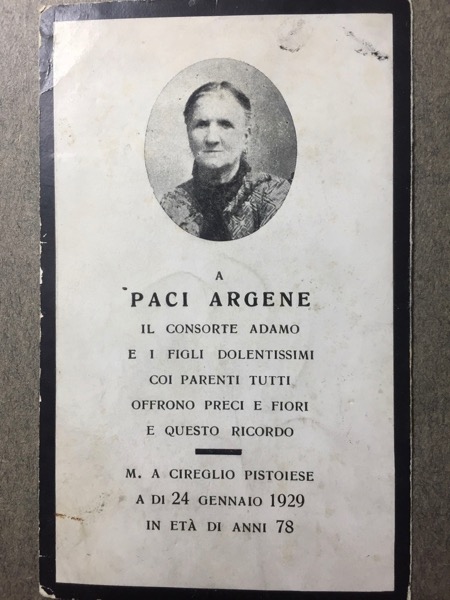
Adamo complains:
Pendine qualcosa meno e quelle di meno forse prendere a babbo tuo che non frequantare te batteghe coll amici, perche il portago gli non le lo perprettana.
It hangs (over) your papa that he less and less frequently struggles (has drinking bouts) with friends because I can’t keep up with them.
He goes on:
Lavorare non posso piu perche me si Pudormoli (pudore) ci la mano e la spalla destra e le rene e le gambe.
Working is no longer possible because of the shame (of the pain) in my hand and right shoulder, and kidneys and legs.
Interestingly he doesn’t mention his eyes which I’m sure he abused over the years with close work as a tailor, which he talks about in the next sentence:
A Cireglio vi sano cinque sarti giovani, ed oggi il vechio sarto non lo condiscano più che fui Io - che Cireglio ebbe it suo sarto.
Cireglio had five young tailors (in years past), but today the old tailor can’t manage anymore - that is I - Cireglio had its tailor.
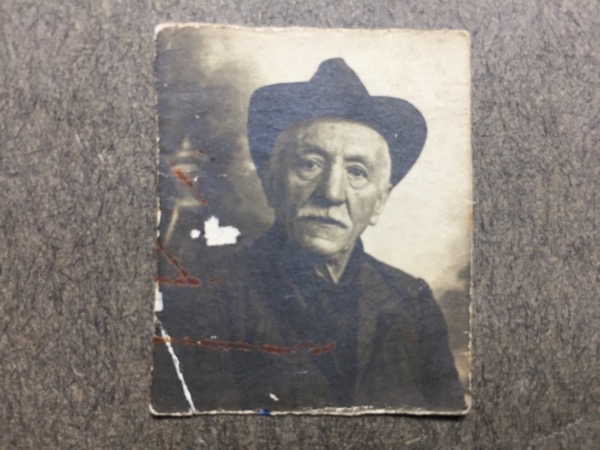
Cireglio’s tailor
He shifts back to Dante:
Etanto tempo che non tue nuove spero di ricerne presto, spero starete tutti bene come me ha partato l’ amico Chiavacci, Pio.
It has been so long since (there was) news of you, I hope to hear from you soon….I hope you are all doing well, as (the news of you) was brought to me by my friend Pio Chiavacci.
And one more reprise on mortality:
Non potere piu lavore me sento molto stanco della vita spero in Dio che me chiami al eterno riposo.
Not being able to work makes me very tired of life, I hope to God that he calls me to eternal rest.
And back to family business:
Tanti saluti ai figli e nipote.
Noi tutte bene, Pacino ha una bella figlia, fa molti affaro pero con me e un -rzo (untranslatable word, see letter below), me ne frego.
Greeting to the children and nephews.
We are all well, Pacino has a beautiful daughter (Fernanda)…however he is busy and is distant to me, (but) I don’t care.
Pacino was Adamo’s fifth child with Argene. He lived in Cireglio and was 40 at the time of this letter. Pacino came to the U.S. in 1912 with Emma, Arturo’s wife, and lived with his brothers in a rooming house on Valley street in Exeter. He worked as a miner for a time, but some time before 1917 he was hit by a trolley car and lost his right leg from just above the knee.
On his draft registration form, dated June 7, 1917 he sadly reports ‘none’ as his present trade; ‘not able to work’ in response to his present employer; ‘no place’ as to where he is working; ‘supported by brothers’ when asked if he has any dependents, and in answer to the form’s question ‘do you claim exemption from draft’ he answered ‘yes, artificial leg.'
Pacino had a rough couple years, and when the war was over returned to Cireglio, and opened a small general store, and married Bianca Nincheri.
Adamo now wraps it up with:
Saluti e baci a tutti e a te secondo figlio i miei augura e felicitazioni in avvenire.
Mille baci dal tua
Padre Adamo
Regards and kisses to you my second son, best wishes and much happiness in the future.
Many kisses from your
Padre Adamo
----------------------------------------------
Dante is buried in the Paci family plot in the Denison Cemetery in Swoyersville, Pa. Adamo and Argene are in a vault in the Cireglio cemetery.
My favorite story about Dante is this conversation with his sister-in-law, my grandmother Fiorina Paci:
Fiorina, one fine day, let’s say Sunday July 25, 1926, says to Dante "Come to church with me. You should go to church more."
Dante says "No, I will never set foot in a church."
Fiorina, rising to the challenge replies "When you die, I am going to bring your body into the church for a mass."
The bachelor says "If you do that, I'll get up and walk out."
Grabbing the last word, Fiorina says "That'll be the first time anyone does that!"
Dante died in 1943 from complications of a broken leg. The accident happened during a visit to his sister Emma and he died in a Newark, N.J. hospital. The body was returned to Exeter, Pa. and taken to St. Anthony’s Church where services were held. It has been reported that he did not get up and walk out, and with a broken leg at the time of his death, he couldn't have even if he had wanted to.
Dante and Arturo Calvani were the family freethinkers.
ADAMO’S LETTER:
